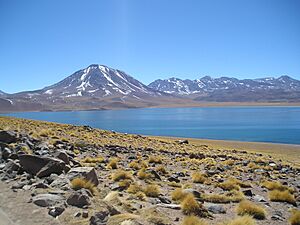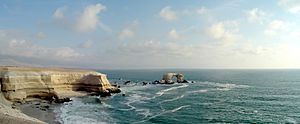Protected areas of Chile facts for kids
The protected areas of Chile are special places in Chile that the government helps to keep safe. These areas are protected because they have amazing natural beauty, important plants and animals, or a lot of history. They cover a huge area, more than 140,000 square kilometers, which is about 19% of all of Chile!
These protected lands are managed by the National Forest Corporation, also known as CONAF. They follow a law from 1984 that helps them protect these wild spaces.
Chile has three main types of protected wild areas:
- National Parks
- National Reserves
- Natural Monuments
What are Chile's Protected Areas?
National Parks
National Parks are large areas that are kept safe because they have unique natural features. This could be amazing landscapes, special plants, or rare animals. The main goal of a National Park is to protect nature for everyone to enjoy and learn from. People can visit these parks to hike, observe wildlife, and appreciate the environment.
National Reserves
National Reserves are also important areas, but they might have a slightly different focus. While they protect nature, they can also be used for things like scientific research or managing natural resources in a careful way. This means that sometimes, certain activities might be allowed if they help with conservation efforts. There are many National Reserves across Chile, each protecting different types of environments.
Natural Monuments
Natural Monuments are usually smaller areas that protect a specific natural wonder. This could be a unique rock formation, a special group of trees, or a place where important fossils have been found. They are like natural museums, showing off amazing parts of Chile's landscape or history.
Nature Sanctuaries
Nature Sanctuaries are places that are protected because they are important for science or education. They often have special plants, animals, or geological features. These areas are carefully managed to keep their unique qualities safe. Some examples include the Carlos Anwandter Nature Sanctuary and the Yerba Loca Nature Sanctuary.
Marine Protected Areas
Chile also protects areas in the ocean! These are called Marine Protected Areas. They help keep the ocean healthy and safe for marine life like fish, whales, and seabirds.
Marine and Coastal Protected Areas
These areas protect both the coastline and the waters near it. They are important for animals that live in both environments, like sea lions or certain types of birds. An example is the Francisco Coloane Marine and Coastal Protected Area.
Marine Parks
Marine Parks are like National Parks, but in the ocean. They are large areas where marine life and habitats are strictly protected. They are great for scientific study and for people to enjoy the ocean in a responsible way. The Nazca-Desventuradas Marine Park is a very large example.
Marine Reserves
Marine Reserves are ocean areas where fishing and other activities might be limited to help fish populations recover or to protect specific habitats. They are important for keeping the ocean's balance. Isla Chañaral Marine Reserve is one such place.
Protected Areas by Region
Chile is a long country, so its protected areas are found in many different regions, each with its own unique climate and wildlife.
Northern Chile
In the dry north, you can find parks like Lauca National Park in the Arica and Parinacota Region, which has high mountains and volcanoes. The Tarapacá Region is home to Pampa del Tamarugal National Reserve, known for its unique desert trees. In the Antofagasta Region, you'll find La Portada Natural Monument, a famous natural arch by the sea.
Central Chile
The central part of Chile, including the Valparaíso Region and Santiago Metropolitan Region, has a Mediterranean climate. Here, you can visit La Campana National Park or the Rapa Nui National Park on Easter Island. The El Morado Natural Monument is a beautiful mountain area close to Santiago.
Southern Chile
As you go south, the climate becomes wetter and greener. In the Los Ríos Region, you can find the Alerce Costero National Park, which protects ancient trees. The Los Lagos Region is home to the famous Vicente Pérez Rosales National Park, Chile's oldest national park, with stunning lakes and volcanoes.
Extreme South (Patagonia)
The very south of Chile, in the Magallanes and Antartica Chilena Region, is known for its wild and rugged beauty. This is where you'll find the world-famous Torres del Paine National Park, with its towering granite peaks and glaciers. The Cueva del Milodón Natural Monument protects a cave where ancient animal remains were found.
Images for kids
See also
 In Spanish: Áreas silvestres protegidas de Chile para niños
In Spanish: Áreas silvestres protegidas de Chile para niños























